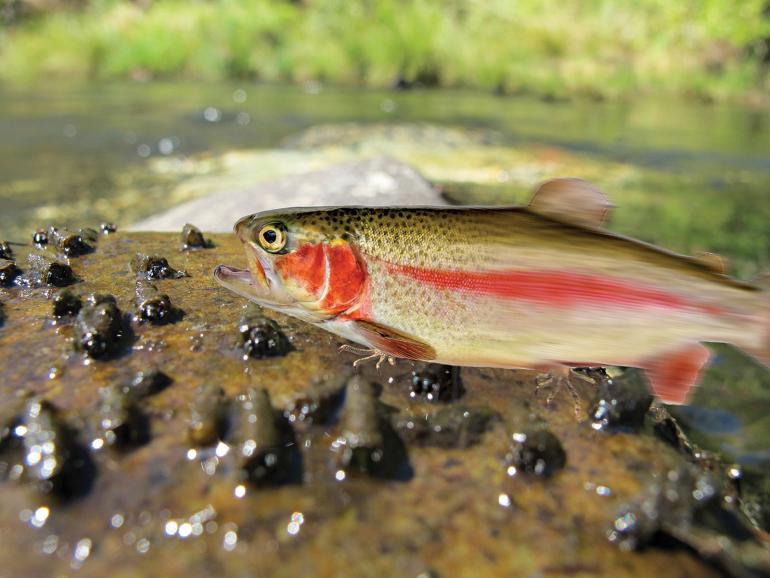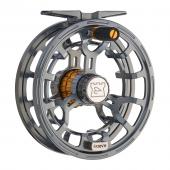Bait & Switch
A moment in evolutionary time.
The Mother’s Day caddis hatch—you’ve heard about it, maybe you’ve seen it. It happens on or around Mother’s Day in western rivers. Certain things have to line up just right for it to go off. The water temperature, for instance, has to be 54 degrees. And the spring weather can’t be too warm or too cold. These, among other things, have to coincide, and when they do, well, get ready for something on the order of a mega-happening.
Brachycentrus occidentalis, popularly known as the Mother’s Day caddis, is a waterborne insect slightly less than an inch long. These critters have huge, transparent wings, double their body-length, that fold like an upside-down V over a skinny thorax and abdomen. They have long antennae, again, double their body size, that stick out forward from their heads and wave like wispy chopsticks. They spend most of their lives as scary, prehistoric-looking larvae crawling around on the bottom of the river. And when conditions are right, they work their way to the surface to hatch in untold numbers and fill the sky like confetti in Times Square on New Year’s Day. There are millions of them. Maybe even billions.
They come to the surface of the river and float in huge, undulating rafts—the water becomes a pulsating carpet of insects. They flutter into the air in a blizzard of gossamer wings, like a whiteout on Mount Everest. And the trout? The trout are in a feeding frenzy of epic proportions. Gorging, gulping, devouring the insects like drunken warriors at a bacchanalian feast. So many trout are rising that it’s difficult to know where to cast your fly. You have to cast onto the surging, heaving blanket and hope that one of the gluttonous fish rises and gobbles your feathery imitation. If and when a trout does take your fly, you’ll hardly know because you can’t see it amid the hullabaloo.
It’s almost too much to comprehend, and yet it’s happening. It’s like something from the mind of Ray Bradbury. But it goes beyond just watching it happen. You become a moving part of it, a player involved in the drama. Caddisflies are everywhere. They obscure your field of sight like driving in a heavy snowstorm. They cling to your legs like thick moss in the rainforest. They crawl up into your nose and mouth. You can feel them in your ears and, if you wear glasses, they creep under the lenses and scuttle around on your eyes. You spend a lot of time swatting them away and spitting them out. Ptoo! Ptoo! They crawl inside your shirt collar and you can feel them creeping about on your chest. When you get home and change your clothes a few sneak out of your pant legs.
Yeah, it’s a trip. If you think I am exaggerating, go ahead and see for yourself.
I have a different take on the phenomenon than that of your typical fly fisherman. I know you’ve seen the cartoon drawings of evolution in action. An amoeba turning into a tadpole, the tadpole growing fins and turning into a frog or a fish, the fish growing legs and crawling out of the river and so on. The progression always culminates into a human walking upright, maybe carrying a briefcase (he should be carrying a fly rod).
Perhaps hundreds of thousands of years pass between each try, but eventually a series of successful attempts leads to a mutation—and a rainbow trout grows legs, and walks on those legs out of the water.
But I saw evolution actually occurring in real time. I stood on the edge of the Yellowstone River near the Carter’s Bridge, in a blustering storm of caddisflies, and watched it take place. After catching several trout, I tied a bandana around my face to cover my nose and mouth and just watched for a while. I swiped insects away as best I could, karate-chopping them away. I watched trout, hundreds of them, rising and scooping flies like humpback whales engulfing anchovies. I giggled in incredulity. It was something out of a sci-fi movie.
A couple rocks stuck out of the water just off the shore. The water around the rocks swirled with commotion. I could’ve hopped over to stand on them if I wanted—probably could’ve stepped across the rug of floating insects without getting my shoes wet. Insects shrouded the rocks like furry mold on an old apple. At one point I noticed a trout, a good-sized rainbow, one that I would have enjoyed catching on a fly. The fish crawled out of the water up onto the rock to eat more insects. Just like the little fish in the cartoon drawing. I imagined it thinking, like something out of a Gary Larson Far Side cartoon, damn these fins, wish I had legs.
It starts there. One tries and then another tries and then another. Perhaps hundreds of thousands of years pass between each try, but eventually a series of successful attempts leads to a mutation—and a rainbow trout grows legs, and walks on those legs out of the water. Maybe it becomes a lizard. Maybe that lizard eventually stands upright. I wish I had a camera handy so I could’ve documented the moment; perhaps sell the photo to National Geographic or Smithsonian. I wish I could say I was moved in a scientific sort of way; maybe write a scholarly paper on the evolution of Oncorhynchus mykiss, the rainbow trout. Possibly win the Nobel Prize. But no. I just stood there laughing, envisioning a Far Side cartoon of a rainbow trout, standing atop the rock, water dripping from its sides, front arm-fins in the air like Rocky at the top of the stairs, with a caption that says something like, “Gonna Fly Now!” or, “Hey, somebody hand me a towel.”
Later, when I got home, I shook a couple of insects out of my underwear.


























